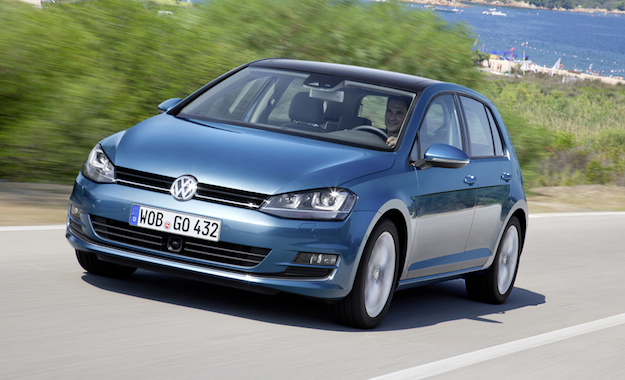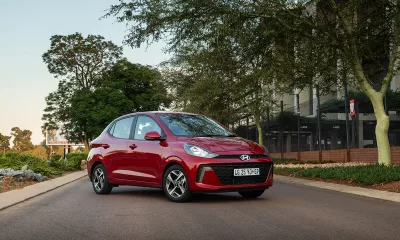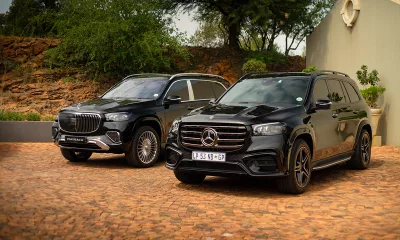If you’re reading this in the hope of coming across some revelation that the new Golf is either a giant leap ahead, or a giant flop, then prepare to be disappointed. New Golf, the seventh generation of this icon, represents a careful evolution over a car that is/was still very much in line for class-best honours. It is the most important car that Volkswagen makes, and the company was not about to mess with a very successful formula. The evolutionary styling, inside and out, is therefore understandable. New Golf will not cost more than its predecessor, either. And from behind the wheel, it is still more about refinement and comfort, than put-your-pants-on-fire dynamics. And yet, in terms of what hides under its cautious skin, new Golf is indeed a significant step forward.
Emphasis on cutting weight, improving economy
New Golf is up to 100 kg lighter than an equivalent sixth-generation car. At the car’s launch in Sardinia, Volkswagen was at pains to detail exactly how this weight loss was achieved. Around 40 kg comes from the engine department, for example, of which the engine block itself contributes 45 per cent, the crankshaft 20 per cent and the connecting rods, 30 per cent. Other savings came from the body and trim (37 kg), chassis (26 kg) and electrics (6 kg). But why this obsession with weight? According to Volkswagen around 25 per cent of fuel consumption is directly attributable to weight and rolling resistance. Cut weight, and you cut fuel consumption.
But the focus has not only been on weight. The new engines have all been developed with the aim of improving economy. When new Golf arrives in South Africa early next year, expect a model line-up that will consist of a 77 kW 1,2-litre TSI, 90 kW 1,4-litre TSI, 103 kW 1,4-litre TSI and 110 kW 2,0 TDI.
The subject of this driving impression is the 1,4-litre TSI (turbopetrol) with DSG. The engine is Volkswagen’s new EA211 unit that develops 103 kW from 4 500 to 6 000 r/min and 250 N.m of torque from 1 500 to 3 500 r/min. When coupled with the marque’s seven-speed DSG dual-clutch transmission, it sips fuel at a rate of only 5,0 litres/100 km. Volkswagen will also offer a version of this engine with automatic cylinder deactivation (ACT), which shuts down cylinders two and three, when not needed. When this engine with ACT is coupled with a DSG transmission, the fuel consumption goes down to a claimed 4,7 litres/100 km. Impressive stuff, and even more so when you consider the performance potential that remains on tap. Volkswagen claims a top speed of 212 km/h and a 0-100 km/h time of 8,4 seconds. Engines with ACT will become available in South Africa during 2014. Also destined for the SA market a few months after the initial introduction are the GTI (July/August), 1,6 TDI and BlueMotion models. Expect to see the hot Golf R in South Africa in 2015.
Premium cabin, more space
Prior to the vehicle’s launch, much had been written about its new Modular Transverse Matrix architecture. Essentially, the emphasis has been on improving parts commonality in the wider VW group – the architecture will underpin a wide range of future models, too. The new architecture has also resulted in the Golf’s front axle being moved forwards by 43 mm, benefiting not only the exterior styling of the car, but also interior space. Overall, the new model is 56 mm longer, 28 mm lower and 13 mm wider. This doesn’t sound like much, but when stretched over a wheelbase that is also 59 mm longer, Golf 7 looks more dynamic than its predecessor. The upshot is also a significantly more spacious cabin.
Like the Golfs before it, the newcomer brings previously unseen levels of cabin refinement to this segment. There is not a line out of place. Nothing is garish. And the materials are really superb. A minor change is that the centre console has been angled slightly more towards the driver for this iteration of Golf. The seats are so good they’re even recommended by a German institute for back health.
With a raft of technologies that were previously the preserve of luxury cars now being offered in the Golf (some standard, some as options), the car continues its task of “democratising” big car technology. The standard infotainment display is a black-and-white 5-inch screen, but VW offers a range of more high-tech and glamorous options, including a 5,8-inch Composition Media player. Other big car items on offer include adaptive cruise control, city emergency braking, fatigue detection, lane assist and park assist (largely automated parking).
On the road
So, new Golf is significantly different under the skin, what is it like from behind the steering wheel? Well, as I mentioned earlier, the focus is still very much on comfort and refinement, and that’s exactly what this segment’s buyers want. The NVH (noise-vibration-harshness) suppression is simply superb – undoubtedly class-leading – and I marvelled at the way the vehicle shrugged off changes in road surface quality. It is a “soft” car in the sense that the there are perceptible amounts of bodyroll in the corners, but there’s good grip and the front-end sticks to the chosen line. The standard XDS transverse electronic differential and second-generation DCC (Dynamic Chassis Control) have roles to play in these regards. The steering, of course, doesn’t chat to the driver, but is well-weighted and accurate enough.
While some buyers may be concerned about the downgrade in power (the 103 kW version replaces the current 118 kW model), they must remember the decrease in weight of the vehicle, and also the fact that the engine features variable intake and exhaust camshafts, which on the one hand improves low-speed responsiveness and on the other torque at higher engine speeds.
The engine pulls cleanly and in a refined manner. When coupled with the seven-speed DSG ‘box as my test car was, it makes for quite an enjoyable companion, in fact. It even sounds quite “raspy”. Overall, I think the basis is there for a cracking GTI!
Summary
To be priced at similar levels to the outgoing model, the new Golf will simply continue the success story for this marque. It offers superb refinement, a spacious, high-quality cabin, loads of high-tech toys and much-improved efficiency. The cautionary design may disappoint some, but as history has shown, the Golf’s conservative design makes it a winner come resale time. It offers a complete package that will be hard to beat. Again.
Specifications:
Model: Volkswagen Golf 1,4 TSI (103 kW) DSG
Engine: 1,4-litre, four-cylinder, turbopetrol
Power: 103 kW/4 500-6 000 r/min
Torque: 250 N.m/1 500-3 500 r/min
Fuel consumption: 5,0 L/100 km (without ACT, see copy)
CO2: 116 g/km
Top speed: 212 km/h
Acceleration (0-100km/h): 8,4 sec
Price: around R270 000
All claimed figures.








